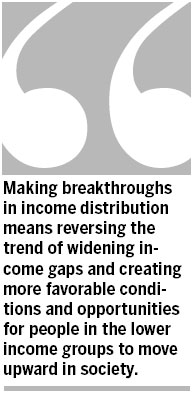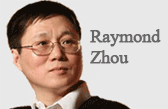Increasing upward mobility
By Chi Fulin (China Daily) Updated: 2012-12-04 08:01
Transformations and tax and industrial reforms are needed to double the size of the middle-income group by 2020
Fostering an expanded middle-income group and unleashing its consumption potential to support national economic growth of 7 to 8 percent is of great significance for attaining more equitable and sustainable development in the next decade.
The essence of the goal of completing the building of a moderately prosperous society in all respects by 2020 is doubling of the size of the middle-income group. With the middle-income group comprising 23 percent of the population at present, this means an annual growth of 2 percentage points to reach 40 percent, around 600 million, by 2020.
China is a large country still undergoing transition and reforms, and doubling the size of the middle-income group by 2020 will largely depend on the transformations and reforms of the next three to five years. Adjusting income distribution relations and narrowing income gaps are two basic conditions for enlarging the middle-income group.
It will be impossible to double the size of the middle-income group without substantially narrowing the income gap between the rich and the poor. Making breakthroughs in income distribution means reversing the trend of widening income gaps and creating more favorable conditions and opportunities for people in the lower income groups to move upward in society.
This means increasing the real incomes of urban and rural residents as soon as possible. The goal of doubling per capita income will only be attained by favoring ordinary residents when distributing the national wealth. For instance, we must make sure that urban and rural residents' incomes grow at the same, or higher, speed than GDP growth. If GDP is to grow at an annual rate of 7 to 8 percent over the next 10 years, the average annual growth in the real incomes of urban and rural residents should not be lower than 7.5 percent. Mechanisms for wage negotiation should be established as soon as possible to ensure that labor remuneration grows at the same speed as improvements in productivity and the share of labor remuneration increases from the current 40 percent of GDP to 50 percent. The income gap between urban and rural residents was 3.23:1 in 2010, and binding indicators must be established to narrow the income gap to a ratio of around 2.8:1 in 2020.
Promoting equal access to basic public services with institutional fairness also needs to be a priority. The government has committed to realizing the overall equalization of basic public services in urban and rural areas by 2020. But although progress has been made, there are still many imbalances in the allocation of public resources between urban and rural areas and among different social groups due to unfair institutional arrangements. This has resulted in a relatively heavier financial burden on people in the lower-income groups as they have to spend larger proportions of their income to pay for housing, old-age insurance, medical care and the education of their children. Consequently, their quality of life has not improved in step with their growing incomes. Thus the gaps in real income have been further widened. Whether the rights and interests of the low and lower middle-income groups can be protected during the process of equalizing basic public services will be one of the key factors in expanding the middle-income group.
Therefore, it is imperative to push forward unifying institutions for providing basic public services for urban and rural areas as well as for different social groups, health services and pension schemes in particular; and to make more efforts to reduce the differences in basic public services investment for different social groups by developing transparent and compulsory indicators. The beneficiaries of affordable housing should be strictly defined and all public housing resources allocated to people in the low and lower middle-income groups so as to consummate the housing security system with low-rent housing as the mainstay, and on this basis to further advance market-oriented housing reforms.
Advancing the strategic readjustment of the allocation of State-owned capital for the universal benefit of the public will also have a decisive role in adjusting the overall pattern of national income distribution. At the end of 2011, the total value of assets operated by State-owned enterprises in China was 83.37 trillion yuan ($13.26 trillion).
Some State-owned capital should exit from competitive sectors and be invested in public services, making State-owned capital an important support for the social security, and the rent on the use of resources and the dividends on State-owned capital should be raised. If the dividends paid to the government by SOEs are raised, there will be additional funds to be used for social welfare every year, which could significantly mitigate economic and social conflicts caused by the shortage of public goods. At the time the excessively high income of employees in monopolistic sectors should be controlled. This can be done by standardizing and controlling the wage and welfare distribution of State-owned enterprises, and by making their income and welfare distribution transparent and monetized so as to substantively narrow income gaps between different sectors; and a total revenue budgetary system should be established, which should particularly include rent for the use of resources and dividends from SOEs so as to institutionally ensure the nature of State-owned capital is utilized for public benefit.
Structural tax breaks are also a crucial way of breaking institutional constraints and enriching the people first. These will not only strengthen economic vitality, but also reduce the financial burden on people in the low and lower middle-income groups. In the next few years, structural tax breaks should focus on small and medium-sized enterprises, which create the most jobs. Reducing the tax burden on SMEs will not only prevent the outflow of capital, it will also create the necessary conditions for raising labor remuneration. Over the next three to five years all business taxes in the service sector should be changed to value-added taxes to substantially reduce the tax burden of the service sector and to enable white-collar workers in the service sector to become part of the middle-income group as soon as possible.
In view of inflation and the need to improve the living standards of people in the low and lower middle-income groups, the personal income tax threshold should be further raised and the personal income tax rate lowered to reduce people's tax burden.
The author is president of the Hainan-based China Reform and Development Institute.
(China Daily 12/04/2012 page8)












